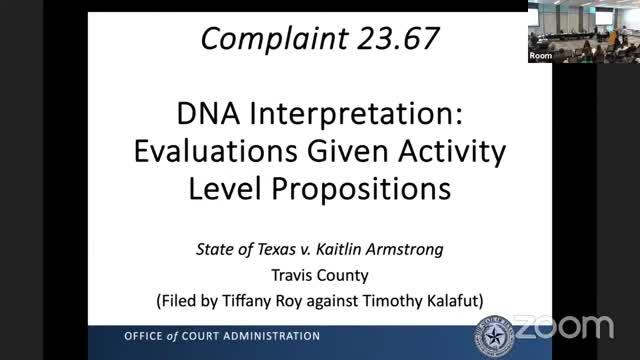Texas DNA Case Unveils Complexities of Forensic Evidence
July 27, 2024 | Texas Courts, Judicial, Texas

This article was created by AI summarizing key points discussed. AI makes mistakes, so for full details and context, please refer to the video of the full meeting. Please report any errors so we can fix them. Report an error »

In a recent government meeting, discussions centered around the complexities of DNA evidence interpretation in the high-profile murder case of professional cyclist Mo Wilson, who was shot in May 2022. The case, State of Texas vs. Caitlin Armstrong, has raised significant questions regarding the reliability and implications of DNA analysis in criminal proceedings.
The meeting highlighted a complaint filed by DNA consultant Tiffany Roy against Dr. Timothy Caliphate, who provided expert testimony in the trial. The commission emphasized that its reports do not comment on an individual's guilt or innocence and are not admissible in court, underscoring the limitations of DNA evidence in legal contexts.
Key points of the case include the DNA analysis performed on a bicycle linked to Wilson's murder. The analysis indicated a three-person DNA mixture, with findings suggesting a likelihood of 224 billion times more probable that the contributors included Wilson, Armstrong, and an unknown individual, compared to other scenarios. However, the DNA analyst, Samantha Perkins, clarified that while the results could identify contributors, they could not determine how or when the DNA was transferred.
The meeting also addressed the challenges faced by DNA analysts in court, particularly regarding \"activity level propositions,\" which explore how DNA may have been deposited. The defense raised questions about alternative explanations for the presence of Armstrong's DNA on the bicycle, suggesting indirect transfer through shared use of a motorcycle and helmet.
Dr. Caliphate's rebuttal testimony aimed to support the prosecution's theory that Armstrong had direct contact with the bicycle. However, his analysis faced scrutiny, leading to the complaint that he deviated from established practices in forensic evaluations. The commission is now tasked with reviewing the testimony and determining necessary improvements in the handling of DNA evidence in the judicial system.
This case exemplifies the ongoing debate over the interpretation of DNA evidence and its role in the legal process, highlighting the need for clear guidelines and standards in forensic science. As the commission continues its review, the implications for future cases involving DNA evidence remain significant.
The meeting highlighted a complaint filed by DNA consultant Tiffany Roy against Dr. Timothy Caliphate, who provided expert testimony in the trial. The commission emphasized that its reports do not comment on an individual's guilt or innocence and are not admissible in court, underscoring the limitations of DNA evidence in legal contexts.
Key points of the case include the DNA analysis performed on a bicycle linked to Wilson's murder. The analysis indicated a three-person DNA mixture, with findings suggesting a likelihood of 224 billion times more probable that the contributors included Wilson, Armstrong, and an unknown individual, compared to other scenarios. However, the DNA analyst, Samantha Perkins, clarified that while the results could identify contributors, they could not determine how or when the DNA was transferred.
The meeting also addressed the challenges faced by DNA analysts in court, particularly regarding \"activity level propositions,\" which explore how DNA may have been deposited. The defense raised questions about alternative explanations for the presence of Armstrong's DNA on the bicycle, suggesting indirect transfer through shared use of a motorcycle and helmet.
Dr. Caliphate's rebuttal testimony aimed to support the prosecution's theory that Armstrong had direct contact with the bicycle. However, his analysis faced scrutiny, leading to the complaint that he deviated from established practices in forensic evaluations. The commission is now tasked with reviewing the testimony and determining necessary improvements in the handling of DNA evidence in the judicial system.
This case exemplifies the ongoing debate over the interpretation of DNA evidence and its role in the legal process, highlighting the need for clear guidelines and standards in forensic science. As the commission continues its review, the implications for future cases involving DNA evidence remain significant.
View full meeting
This article is based on a recent meeting—watch the full video and explore the complete transcript for deeper insights into the discussion.
View full meeting
